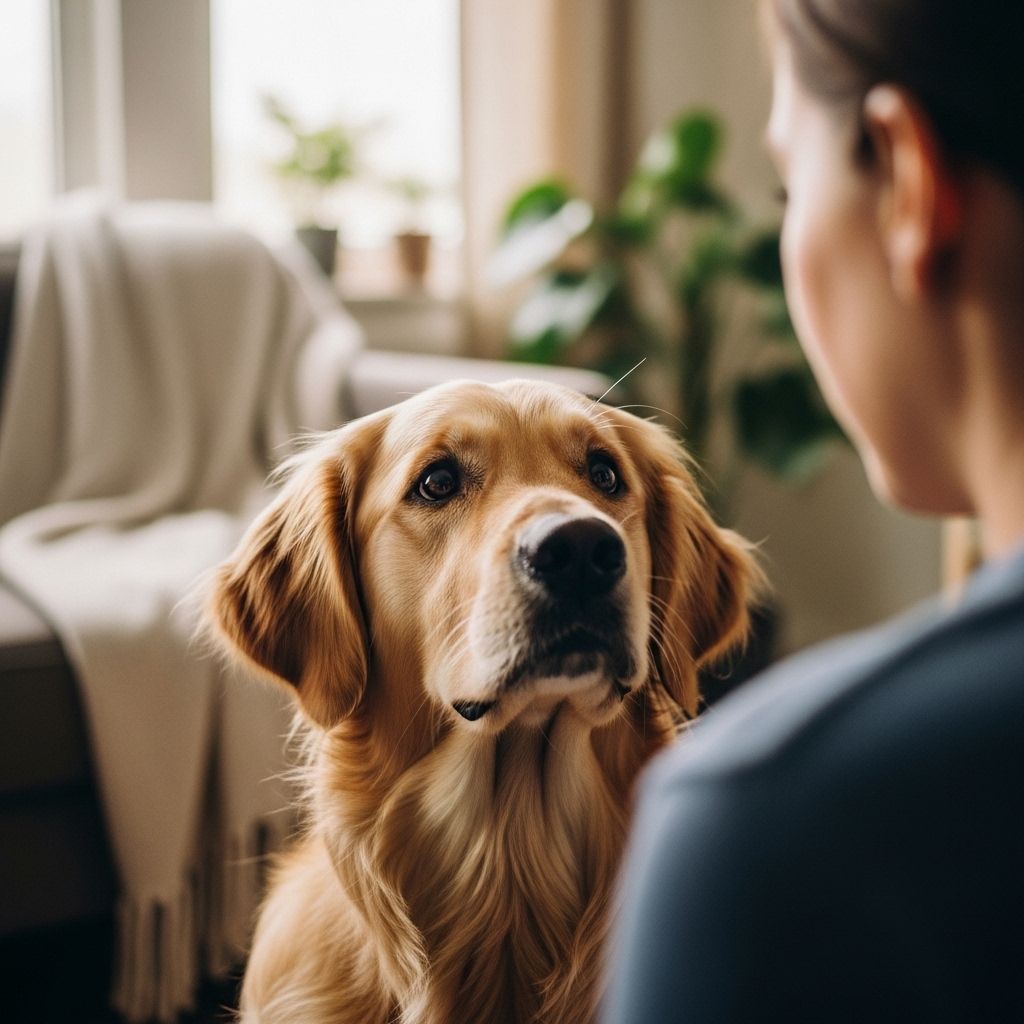Why Does My Dog Stare At Me? 6 Key Reasons Explained
Decode the many reasons behind your dog's stare and what it reveals about your bond and their needs.

Image: HearthJunction Design Team
Why Does My Dog Stare at Me?
Most dog owners have experienced that moment—settling onto the couch or glancing across the room—only to find their canine companion gazing intently at them. Sometimes the look is soft and soulful, and other times it’s persistent or even watchful. But why do dogs stare at their people? The answer is both simple and complex, rooted in their evolutionary history, emotional intelligence, and desire to communicate.
The Many Meanings Behind a Dog’s Stare
When your dog fixes their gaze on you, they could be trying to convey a wide range of messages. Understanding the context, accompanying body language, and your unique relationship helps decipher these cues. Let’s break down the most common reasons why your dog might stare:
- Affection and Bonding: Staring is often a sign of love and deep attachment. When dogs lock eyes with their humans, both parties experience a release of oxytocin—the so-called “love hormone”—which strengthens their bond and trust.
- Communication: Dogs cannot talk, so they use their eyes and body language to communicate. A stare may mean they want something or are trying to get your attention for a specific need.
- Seeking Guidance: Many dogs look to their humans for cues or instructions, especially during training or when unsure how to behave.
- Anticipation: Dogs quickly learn routines, and if they expect a walk, treat, or meal, they may stare to remind you of your duties!
- Expression of Emotion: Stares can reflect a wide range of emotions—curiosity, anxiety, excitement, or even stress—depending on the context and the dog’s personality.
Scientific Insights: The Hormone Oxytocin and Gazing
Recent scientific studies highlight the power of shared gazes between dogs and their humans. Researchers found that when dogs and people gaze at each other, both species experience an increase in oxytocin levels, the same hormonal response mothers and infants have during bonding. This mutual exchange deepens trust, affection, and the human-canine relationship.
Notably, the emotional context of a stare matters. In one study, dogs fixated longer on human faces with happy expressions after their oxytocin levels were boosted, and tended to avoid the eyes of angry faces. The hormone appears to guide dogs toward more positive social interactions and away from potential threats.
Common Reasons Your Dog May Be Staring at You
Understanding your dog’s specific motivation behind a stare involves observing the situation and their overall demeanor. Here are some of the frequent underlying reasons:
- Affection: Your dog simply loves you and enjoys looking at you. Eye contact is a way to feel connected and safe.
- Anticipating Rewards: Dogs are astute learners and often stare when expecting food, treats, or playtime, especially if staring has yielded results before.
- Seeking Attention or Communication: If your dog wants a walk, needs to go outside, or simply craves affection, they might use a focused gaze to prompt you.
- Reading Your Mood: Dogs are highly tuned to human emotions and may stare to read your facial expressions or gauge your mood.
- Confusion or Seeking Guidance: During training or an unfamiliar situation, dogs may look to their human for reassurance or instruction.
- Medical or Behavioral Issues: Persistent, blank, or unusual staring may signal a medical concern (such as cognitive dysfunction syndrome or compulsive disorders) and warrants consultation with a veterinarian.
Table: Meanings Behind Different Types of Dog Stares
| Type of Stare | Possible Meaning | What to Do |
|---|---|---|
| Soft, Blinking Stare | Affection, Trust | Enjoy the moment, return gentle eye contact |
| Intense, Focused Stare | Anticipation, Request | Check if your dog needs something |
| Unblinking Hard Stare | Threat, Stress | Avoid direct gaze, assess situation |
| Blank or Distant Stare | Medical Concern | Consult a veterinarian if persistent |
Breed Differences: How Genetics Influence Gazing
Not all dogs use eye contact in the same way. Some breeds, especially those bred for close human interaction (like herders or service dogs), may seek eye contact more naturally than independent breeds. For example, Border Collies and Golden Retrievers may stare frequently to check in with their humans during work or play.
In contrast, breeds with a strong independent streak or those developed for guarding may use prolonged eye contact as a challenge or warning sign. Always consider your dog’s breed tendencies when interpreting their behavior.
Is Staring at Your Dog a Good Idea?
Gazing back at your dog can strengthen your bond if the stare is relaxed and affectionate. However, a hard, unblinking stare—especially to a dog you do not know—can be perceived as a threat. Dogs, like wolves, may interpret direct, intense eye contact as dominance or aggression. This is particularly important when interacting with unfamiliar or nervous dogs. In these cases, it’s best to avoid direct stares to prevent misunderstandings or provoke anxiety.
Understanding Dog Body Language Alongside Staring
A stare is only part of the story. To fully interpret what your dog is communicating, observe their entire body language:
- Relaxed Body & Soft Eyes: Signals affection and comfort.
- Stiff Posture & Hard Eyes: Indicates alertness, stress, or threat.
- Whining, Tail Wagging, or Pawing: Often paired with a stare to intensify the request for attention or play.
- Averting Eyes: Shows submission or an attempt to deescalate perceived tension.
When to Be Concerned About Your Dog’s Staring
While most staring is normal, there are situations where it might point to medical or behavioral issues. If your dog is staring at the wall, into space, or seems otherwise disengaged from their environment, possible causes include:
- Cognitive Dysfunction Syndrome (CDS): Akin to dementia in older dogs, affects orientation and awareness.
- Seizure Activity or Neurological Disorders: Some forms of epilepsy manifest as staring spells.
- Compulsive Behavior: Obsessive staring can develop if accidentally reinforced or as a sign of anxiety.
If you notice persistent, contextless staring—especially with other changes in behavior—record the episodes and consult your veterinarian. Many underlying causes are treatable once properly diagnosed.
What To Do If Your Dog Stares at You
- Respond with Calm and Affection: If the stare is soft and gentle, reciprocate with pets or gentle words. This fosters trust and happiness.
- Assess Their Needs: If your dog seems to be communicating a request (for food, play, bathroom breaks), address or gently redirect the behavior if necessary.
- Monitor for Stress: If the stare is hard, paired with tense body language, or coming from an unfamiliar dog, avoid direct eye contact and give them space.
- Observe for Medical Issues: Unusual or repetitive staring, especially with confusion or disorientation, warrants a veterinary check-up.
Frequently Asked Questions (FAQs)
Q: Why does my dog stare at me while I eat?
A: Your dog may be hoping for a snack or waiting for food. Dogs learn that staring can prompt humans to share, especially if this behavior has been rewarded in the past.
Q: Why does my dog stare into space or at the wall?
A: Occasional staring at nothing can be normal, but persistent episodes—especially in older dogs—may signal medical issues such as cognitive dysfunction syndrome, seizures, or compulsive behaviors. Consult a veterinarian if concerned.
Q: Should I stare back at my dog?
A: Staring gently and lovingly can strengthen your bond, but avoid prolonged, hard eye contact, especially with unfamiliar or nervous dogs, as this can signal aggression.
Q: Is it normal for my dog to make eye contact during training?
A: Yes! Many dogs seek eye contact for guidance and reassurance during training. Cultivating gentle eye contact can improve your training communication.
Q: Do all dog breeds stare the same way?
A: No. Some breeds, like herders or working dogs, may seek eye contact more frequently, while independent breeds might use it more sparingly.
Conclusion: The Power of the Canine Gaze
When your dog stares at you, it’s usually more than meets the eye. These gazes are rooted in affection, communication, curiosity, or even a biological urge to bond. While most stares are positive and a testament to your special relationship, owners should stay attuned to context and body language for signs of discomfort or underlying health concerns. By responding thoughtfully to your dog’s stares—whether with warmth, guidance, or by seeking veterinary advice—you strengthen trust and understanding across the leash.
References
- https://www.akc.org/expert-advice/training/why-you-shouldnt-stare-down-a-dog/
- https://www.akc.org/expert-advice/health/why-dog-staring-at-wall/
- https://www.akc.org/expert-advice/lifestyle/dog-breeds-seek-eye-contact-differently/
- https://www.akc.org/expert-advice/training/how-to-read-dog-body-language/
- https://www.akc.org/expert-advice/lifestyle/dog-eye-movement-gives-insight-into-emotions/
Read full bio of Shinta












